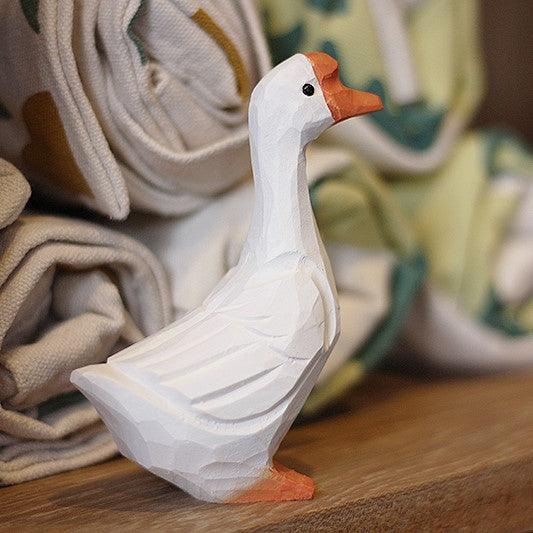
The Timeless Relationship Between Geese and Humans
Share
A Bond That Spans Millennia

Geese have been a part of human history for thousands of years, playing roles in agriculture, culture, and even mythology. These large, social birds have shared a complex and multifaceted relationship with humans, from being domesticated for food to becoming symbols of loyalty and guidance. In this blog, we explore the enduring connection between geese and humans, highlighting the various ways these birds have influenced and interacted with human societies across the globe.
Domestication and Agriculture
One of the most significant aspects of the relationship between geese and humans is their domestication. Geese were among the first birds to be domesticated by humans, with evidence of domesticated geese dating back to ancient Egypt around 3000 BCE. The ancient Egyptians valued geese for their meat, eggs, and feathers, and they were often depicted in tomb paintings and hieroglyphics as symbols of abundance and prosperity.
Throughout history, geese have continued to play a vital role in agriculture. Their natural foraging behavior makes them excellent at controlling weeds in fields, particularly in rice paddies, where they can eat unwanted plants without harming the crops. This practice, known as "goose weeding," has been used in various parts of the world, including China, where geese have been employed in agriculture for centuries.
Geese are also highly valued for their feathers, which have been used for bedding, clothing, and quill pens. The soft down feathers of geese are particularly prized for their insulating properties, making them ideal for use in blankets and jackets.
Cultural and Mythological Significance
 Geese hold a special place in many cultures and mythologies, often symbolizing loyalty, protection, and guidance. In ancient Rome, geese were considered sacred to the goddess Juno, and the "Capitol Geese" were famously credited with saving the city by alerting the Romans to an approaching enemy attack. This event solidified the goose's reputation as a vigilant and protective animal.
Geese hold a special place in many cultures and mythologies, often symbolizing loyalty, protection, and guidance. In ancient Rome, geese were considered sacred to the goddess Juno, and the "Capitol Geese" were famously credited with saving the city by alerting the Romans to an approaching enemy attack. This event solidified the goose's reputation as a vigilant and protective animal.
In Chinese culture, geese are symbols of fidelity and marital harmony. They are often depicted in art and literature as loyal companions, representing the deep bond between partners. The migratory behavior of geese, with their lifelong mating pairs and synchronized flights, has further reinforced this association with loyalty and togetherness.
In Native American mythology, geese are seen as spiritual guides, representing the journey of the soul and the connection between the earthly and spiritual realms. Their migratory patterns are often viewed as a metaphor for life's journey, with geese serving as symbols of perseverance, community, and direction.
Geese in Modern Times: Companions and Protectors
In more recent times, geese have continued to play important roles in human life. Many people keep geese as companions or as "watchdogs" due to their loud, honking calls, which can alert homeowners to intruders. Geese are naturally protective and will defend their territory aggressively, making them effective guardians for farms and homes.
The bond between geese and humans can be surprisingly strong. Geese are intelligent and social animals that can form close relationships with their human caretakers. They can recognize faces, respond to names, and even display affection, making them endearing and loyal companions.
Conservation and the Role of Geese in Ecosystems
As human populations have expanded, geese have had to adapt to changing environments. While some species of geese have thrived in human-altered landscapes, others have faced challenges due to habitat loss, hunting, and climate change. Conservation efforts are essential to protect these birds and ensure their continued survival.
Geese also play a crucial role in ecosystems as grazers and seed dispersers. Their foraging habits help maintain healthy grasslands and wetlands, while their migratory patterns contribute to nutrient cycling across large geographical areas. By protecting geese and their habitats, humans are also safeguarding the health of these vital ecosystems.
The Future of Geese and Human Interaction
 The relationship between geese and humans is likely to continue evolving as we navigate the challenges of the modern world. As urbanization and climate change impact goose populations, it will be important for humans to find ways to coexist with these birds, ensuring that they remain a valued part of our shared environment.
The relationship between geese and humans is likely to continue evolving as we navigate the challenges of the modern world. As urbanization and climate change impact goose populations, it will be important for humans to find ways to coexist with these birds, ensuring that they remain a valued part of our shared environment.
In addition to conservation efforts, there is growing interest in sustainable farming practices that incorporate geese, such as organic weed control and the use of geese in integrated pest management. These practices not only benefit farmers but also support the well-being of geese by providing them with natural habitats and diets.
A Relationship of Mutual Benefit and Respect
The relationship between geese and humans is one of mutual benefit and respect, built on thousands of years of shared history. From their role in agriculture to their symbolic significance in culture and mythology, geese have left an indelible mark on human society. As we look to the future, it is important to continue nurturing this relationship, ensuring that geese remain a thriving and integral part of our world.








